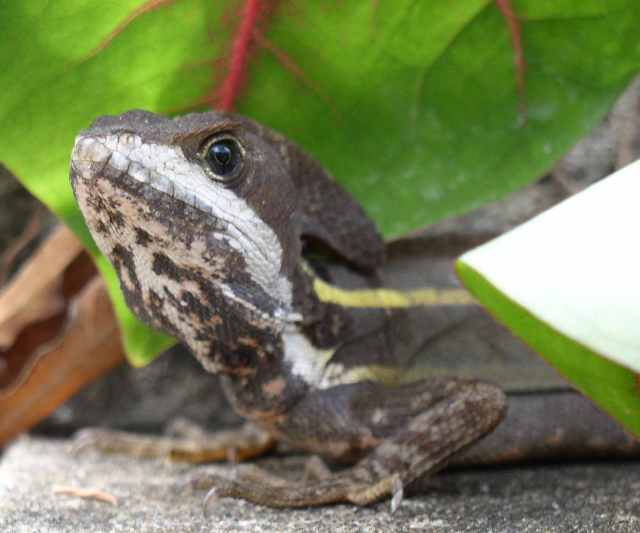- Brown basilisk
Taxobox
name = Brown Basilisk

image_width = 200px
image_caption = Striped or Brown Basilisk
regnum =Animal ia
phylum = Chordata
classis = Sauropsida
ordo =Squamata
subordo =Iguania
familia =Corytophanidae
genus = Basiliscus
species = "B. vittatus"
binomial = "Basiliscus vittatus"
binomial_authority = Wiegmann, 1828The Brown basilisk or Striped basilisk ("Basiliscus vittatus"; in some areas referred to as "common basilisk") is one species of basilisk lizard. They are native to Central America, but have been introduced into the
U.S. state ofFlorida as aferal species.cite book | last =Conant | first =Roger | last2 =Collins | first2 =Joseph |authorlink=Roger Conant (herpetologist) | title =A Field Guide to Reptiles and Amphibians Eastern/Central North America | publisher =Houghton Mifflin Company | date= 1991 | location =Boston, Massachusetts | isbn = 0395583896 ]Along with the
Common Basilisk they have the nickname "Jesus Lizard" because when fleeing from a predator, they are very fast and can even run on top of the water. Basilisks actually have large hind feet with flaps of skin between each toe. The fact that they move quickly across the water, aided by their web-like feet, gives them the appearance of "walking on water ".Taxonomy and etymology
The Brown Basilisk's generic name "basiliscus" is taken from the creature of
Greek mythology made up of parts of arooster ,snake , and lion which could turn a man to stone by its gaze: theBasilisk . This name derives from the Greek "basilískos" (βασιλίσκος) meaning "little king". This epithet was given inCarolus Linnaeus ' 10th edition of "Systema Naturae ". Smaller basilisks can run about 10-20 meters on the water without sinking. Young basilisks can usually run farther than older ones. If the animal faces danger, it starts to run very fast on the surface of a river or a lake. Then the flaps on its hind feet are opened and thus more surface area is provided for it to run on water.They are in the same infraorder as the
iguanid family.Like most reptiles, basilisks are active during the day. They have long toes and sharp claws. Most are under a foot in length, but some may grow up to two feet. Basilisks usually weigh between 200-600 grams. Their maximum lifespan is probably around 7-8 years. In the wild, most die much sooner. Females lay about 2-18 eggs, five to eight times a year. Eggs hatch after about three months and the babies weigh about 2 grams. Their outstanding camouflage allows them to remain motionless and very hard to detect.References
Wikimedia Foundation. 2010.
